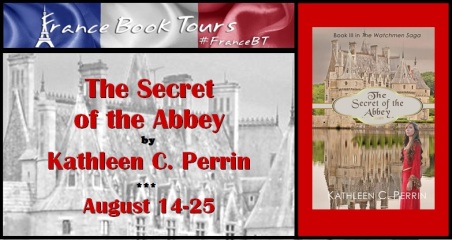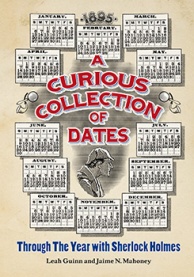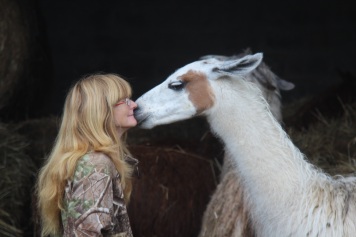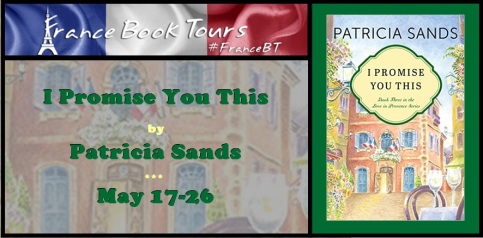My Review
The Secret of the Abbey is the third book in Kathleen C. Perrin’s impressive series of historical romances, The Watchmen Saga, set in medieval France. All these books have gorgeous covers displaying on-site photography; Perrin acknowledges her daughter Christine for their design. Book III has perhaps the most beautiful cover so far. The young woman’s face mirrors the alert intelligence and strength of purpose of the book’s heroine, Katelyn Michaels, and the red gown will figure in the plot.
In each installment of the saga, Katelyn travels back in time to three key moments in the history of France, when the outcome of events will determine the fate of Mont-Saint-Michel and its survival as a stronghold of faith. In The Keys of the Watchmen, Katelyn receives her unexpected calling as a Watchman and discovers her first mission defending the Mount in 1424 against an attack by English forces during the 100 Years’ War. In The Sword of the Maiden, Katelyn returns to a point five years later when her mission takes her to meet Joan of Arc. Katelyn proves to be the perfect counselor and friend for La Pucelle, the Maiden, who must overcome serious obstacles–opposition from her countrymen and struggles within herself–before she can fulfill her own calling to save France. Katelyn knows that history must take its course, because securing the French throne will also safeguard Mont-Saint-Michel, but it is agonizing to watch her friend, Jehanne, the courageous maiden, suffer her cruel destiny as a martyr.
Ultimately, it is the Archangel Michael who is the defender of Mont-Saint-Michel. The Watchmen receive their calling and their instructions through his spiritually intimated instructions. Jean Le Vieux (his name means ‘the old one”) passes along his wisdom as he trains Katelyn, young Nicolas le Breton, and the middle-aged, retired Brother Thibault, all of whom will play key roles in protecting The Secret of the Abbey. They are needed because the most dangerous foe of the Mount is not earthly at all but rather a fallen angel named Abdon who inhabits a series of bodies of wicked men with the aim of discovering the secret of the ancient stones that are hidden deep within the abbey of Mont-Saint-Michel. Abdon and his master hope to usurp the power of the stones in service of cosmic evil.
At the end of Book II, Nicolas was gravely injured in a battle with Abdon’s host, whom he killed, and he was still in a coma. Katelyn was herself near despair. Brother Thibault sent her back to the future (without her consent), to her home and family in America, hoping to spare her months, perhaps years, of anguish. That is where The Secret of the Abbey takes up the thread of all their lives. Unable to share her feelings with anyone in her time, Katelyn resumed her life, finished high school, and wrote an account of her adventures with Joan of Arc, disguised as a historical novel. Presumably, this was Book II, The Sword of the Maiden. This novel turns out to be a surprise publishing success, and she receives a sizeable advance to write a prequel. She will use this money to travel back to France and hopefully return to her beloved Nicolas, provided the Archangel lays the groundwork. She inherits an inn on the Mount, not so fortuitously called L’Auberge de l’Archange (the inn of the Archangel), and it seems she has been provided with the means to stay in France and provide for herself and her family to join her there. She promptly takes up this opportunity and begins managing the inn, while she waits for her next mission from the Archangel to be communicated to her.
Meanwhile, back in the 15th century, Nicolas wakes from his coma, but with amnesia for the last several years. He does not remember Katelyn or their missions together. Nor does he remember the death of their beloved mentor, Jean Le Vieux. Brother Thibault, who has been faithfully caring for him, fills him in on events as best he can, but he hesitates to reveal to Nicolas his relationship with Katelyn in his present state of mind. A time-traveling Jean Le Vieux pays Nicolas a visit, and tries to quiet his indignation over his amnesia.
Oh, my dear Nicolas. This is not a new teaching for you. We have spoken of it many times, my son. Life is not just. Indeed, it is a necessary condition of mortality. For us to be truly tested, to see whether we will choose good over evil, there must be opposition in all things. If there were no opposition, ‘twould not be a test. The power of evil is real, and God cannot shelter you from the consequences of your own choices, or from the evil acts of others that may affect you, even when you stand blameless.
Jean Le Vieux also brings Nicolas news of his next mission, which will take him 150 years into the future, and shares the Archangel’s plans for Brother Thibault, who is instructed to marry! No one is more surprised at this than Thibault himself, and he wonders who would want to marry him? Only an exceptional woman who could see his heart. Thibault had learned a great deal from Katelyn about sanitary practices and caring for the sick effectively; she also left him with some medicines. One day, a girl comes to the abbey imploring his help as healer for her gravely ill sister. It is the sister, Amée, who will become his future wife. The scene in which Thibault administers life-saving treatment to Amée brought tears to my eyes–and this was only page 97! Perrin’s beautiful writing drew me in to care about Amée as Thibault did and to marvel at Thibault’s own depth of feeling for this woman–a new experience for him.
His marriage was crucially important because Nicolas, traveling to the year 1577, would lodge in Jean Le Vieux’s old cottage–so familiar to him–but now owned by one Thomas Thibault, a descendant of Nicolas’s old friend. Thomas was himself an appointed Guardian of Mont-Saint-Michel and a trustworthy keeper of the family papers and the covert business of the Watchmen. He carefully explained to Nicolas the political situation of the times, pitting Catholics and Huguenots (French Protestants) against each other in the French Wars of Religion. The Saint Bartholomew’s Day Massacre (1572) was a bloody precursor of the hatreds rampant at the time of Nicolas’s arrival. Perrin provides ample historical endnotes to clarify some of the political and religious rivalries, along with family trees of the Catholic Valois and the Huguenot Bourbons.
But don’t worry that you need to memorize all this background to follow the adventure to come. As soon as Katelyn travels with Nicolas back to Thomas Thibault’s cottage and begins to share his mission, the story takes off at a gallop and all the necessary history is seamlessly introduced by Katelyn where needed to advance the plot. Katelyn’s personality continues to leap off the page in this third installment of the saga, and Perrin’s writing is strongest when she is writing in the voice of this marvelously alive young woman. She and Nicolas must re-learn how to communicate in several languages–French, English, and Katelyn’s frank and colloquial American speech–to bridge the cultural gap of centuries between them, when he comes to fetch her in the 21st century.
“Look, I know you don’t remember me,” she continued, switching from French to English, “but it’s okay. We’ll take this slowly.”
He had forgotten that he spoke English so well, and yet he understood her perfectly…except for that odd word. Okay, okay. He tumbled the word around in his mind. He knew it meant something, but he couldn’t remember. However, at least she knew he suffered from memory loss, and she did not reproach him for it.
“I apologize, Mademoiselle Michaels, but ’tis true. I do not remember you or anything about you,” he replied. He saw what he judged to be a glimmer of sadness in her eyes as he said these words. “But I assure you, it will not prevent us from working together as the Archangel has instructed. You are to return with me as quickly as you can prepare yourself.”
“First of all, we have to get this straight,” she said as she met his gaze again. “You are to call me Katelyn, not Mademoiselle, and not Mademoiselle Michaels. We’ve been through this before, so don’t fight me on it. Okay?”
“It…it,” he muttered like an idiot, “it feels so uncomfortable for me to call someone I don’t know by her given name.”
“I know, I know,” she said. “I get it, but get over it because you do know me, and like I say, we’ve been through it all before. Just humor me on this, won’t you please? It’s Katelyn.”
“Katelyn,” he said. “And what is this ‘okay’ you keep using?”
“Oh for heaven’s sake,” she said, and he could sense she was frustrated. “Déjà vu. Like I said, we’ve been through all of this before. As you will soon find out, I can’t speak without using the word ‘okay,’ so you’d better learn it fast….” (pp. 220-221)
Katelyn was warned that Nicolas would not remember their relationship–neither their romance nor their marriage in the 15th century. But Abdon and the French Huguenots are on the move and that is their first priority. There is a wonderful moment when Katelyn wins over the French governor of the Mount to her plan, using a combination of assertive argument and subtle threats. Nicolas is enormously proud of her abilities, and yet confused by the strength of his feelings for her. As usual for them, there is “no time” for them to work this out before being separated; Nicolas and Katelyn each go undercover with prominent French Huguenot families to learn their plans vis-à-vis Mont-Saint-Michel. The unfolding of events is beautifully plotted. I admire Perrin’s skill in working out all the complex details to contribute to the big picture, consistently and meaningfully.
Katelyn is the only one of the Watchmen who doesn’t know the Secret of the Mount, the one she’s nevertheless been protecting through all their battles and trials. This was decided for her protection, and in foresight of some of the attempts Abdon would make to wring the secret from her. In Book III, she will finally learn the secret, along with some surprising revelations about herself and her family. The secret the Watchmen have been protecting for centuries is–well, of course, I can’t say. But it is worth waiting, along with Katelyn, for the perfect moment to reveal it. It is an interesting mix of theology and cosmology extrapolated imaginatively into the world of this story. I suspect it is influenced by the author’s personal beliefs and faith tradition–which is her right. My one objection might be to some of the anticlericalism voiced by Nicolas and Jean Le Vieux, which sounded a bit anachronistic for 15th-century Catholics immersed in the pervasive piety of a place like Mont-Saint-Michel.
At the end of this highly enjoyable reading journey, I can highly recommend this book and the whole Watchmen Saga. Kathleen Perrin is equally strong in creating engaging, believable characters and in managing complex plots, transforming them into well-paced, suspenseful, and romantic fiction. And she does her research! I have to say that Katelyn and Nicolas are people I’d want to meet in any century, and I feel that special fondness for them that only a gifted writer can inspire.
***
Kathleen C. Perrin
on tour
August 14-25, 2017

The Secret of the Abbey
(historical fiction)
Release date: June 3, 2017
Self-published at Langon House
565 pages
ISBN: 978-0692877975
SYNOPSIS
After unwillingly leaving a comatose Nicolas behind on Mont Saint Michel in 1429, Katelyn Michaels is distraught to be back in the United States in modern times. When a series of remarkable events facilitates her taking up residence on the Mount and reveals why Katelyn was called as a Watchman, her fondest hope is to be reunited with Nicolas, regardless of the circumstances. However, when Nicolas unexpectedly arrives with a new mission for her, Katelyn is devastated to learn that his head injury has deprived him of any memories of their relationship. Nonetheless, she is determined to once again save the Mount—this time in sixteenth-century France amidst violent religious turmoil—and rekindle Nicolas’s feelings for her. The couple’s love and loyalty is tested as she and Nicolas attempt to unmask the true source of the threat¬—their adversary Abdon—sort out their conflicting emotions, and deal with the consequences of an astounding age-old secret.
ABOUT THE AUTHOR
 Kathleen C. Perrin
Kathleen C. Perrin
holds bachelor’s degrees in French and Humanities
from Brigham Young University and is a certified French translator. Besides being the author of The Watchmen Saga, she has published several non-fiction articles, academic papers, and a religious history about Tahiti.
Kathleen has lived in Utah, New York City, France, and French Polynesia. She and her French husband have spent years investigating the mysteries and beauties of his native country—where they have a cottage—and have taken tourist groups to France. The Perrins have three children and currently reside in Utah.
Visit her website.
See here gorgeous pictures related to the book.
Buy the book on Amazon
***
GIVEAWAY
Enter here
Visit each blogger on the tour:
tweeting about the giveaway everyday
of the Tour will give you 5 extra entries each time!
[just follow the directions on the entry-form]
Global giveaway open to all
8 winners
***
CLICK ON THE BANNER TO READ REVIEWS,
GUEST-POST AND EXCERPT
*Note*: I received a copy of the title from the publisher for purpose of honest review. I was not compensated for this review: all conclusions are my own responsibility.




















 Time and Regret is M.K. Tod’s third novel.
Time and Regret is M.K. Tod’s third novel.





 Her prequel novella Love and Entropy flashes back to a particularly disturbing incident that happened that first summer when Greta and Daphne knew each other and became inseparable. Second, there is
Her prequel novella Love and Entropy flashes back to a particularly disturbing incident that happened that first summer when Greta and Daphne knew each other and became inseparable. Second, there is  Katie Rose Guest Pryal
Katie Rose Guest Pryal






































Recent Comments